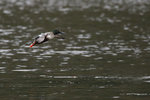



All winter long, on the lakes, ponds, and wetlands of Thurston County, we have opportunities to check out a variety of ducks. They are wintering here before flying off next spring to breeding territories in the interior of North America. Most of these are dabbling ducks that feed on vegetation and bugs at the water’s surface. They may be found as scattered pairs and sometimes in mixed-species flocks. Last week I described Mallards and Pintails. This week we are continuing with more dabbling duck species.
One of the most common ducks in winter is the American Wigeon. These are medium-sized ducks with strong differences between sexes. The male is readily identified by a wide green swatch behind the eye that contrasts with a bright white cap. In times past, this white cap reminded people of bald heads, thus accounting for the old-fashioned name for this duck - “baldpate.” The male’s body is a warm cinnamon, with white on the sides of his rump and black tail feathers. The female is a dull lighter brown with a grayish-brown head. Both sexes have a gray bill with a black tip.
These birds are sometimes found in good numbers grazing at the water’s edge or on nearby grassy fields. And interestingly, it seems that they are always vocalizing, talking to each other with a distinctive, airy whistle contact call. When they are resting, they pull in their necks and look short-necked. You might see (and hear) these ducks anywhere, from larger freshwater sites to marine shorelines.
Another common wintering duck in our area is the Northern Shoveler. This species has a distinctive large, shovel-like bill that is always a sure identification feature. You’ll find this species most often in shallow water where it feeds, moving its bill side to side filtering out food particles. The male’s bill is black; the female’s is orangish.
As with many duck species, the males sport showy colors compared with the female’s scalloped brown head and body. The male’s body has a boldly contrasting white breast, rusty brown sides, and a white rump. He has an iridescent greenish head and yellow eyes.
There’s one more fairly common dabbling duck in our area: the Gadwall. This duck is about mallard-sized and is a bit harder to identify since the males don’t have bold color patterns. Males are brownish gray, browner on the head and grayer on the body. And there’s a black patch on the rump and a smallish black bill. The female is a scalloped brown with a dark orangish bill. Both species have a white wing patch that is often visible when they are on the ground.
Gadwalls are often seen in pairs since they seem to select mates fairly early during the wintering season. They often occur with other dabbling ducks, feeding on vegetation in shallow water, sometimes tipping up to grab submerged plants.
I’ve been describing features you can readily see when they are resting or feeding (that is, on the ground or in the water). That’s where I personally like to look at ducks. However, since they’re birds and often fly around, they can also be identified by wing colors and flight patterns. Hunters become quite skilled at on-the-wing identification.
Some folks like to test their identification skills on flying ducks; it can be quite a challenge. So here are some hints about what you can see when they are in flight above you.
Gadwalls have that distinctive white wing patch. Shovelers have a bold green wing patch behind a white stripe; their wings are gray overall, and that shovel-shaped bill is always noticeable. Wigeons also have both a dark greenish wing patch and a bold white patch, with a black strip between the two. Pintails, described in detail last week, also have a small green wing patch with a trailing white stripe, and their pointed tail is distinctive. Mallards have blueish or purplish wing patches with white stripes before and after.
If you can identify them all on the wing, you can call yourself an expert, and I won’t argue with you.
George Walter is the environmental program manager at the Nisqually Indian Tribe’s natural resources department; he also has a 40+ year interest in bird watching. He may be reached at george@theJOLTnews.com
Photos for this column are provided by Liam Hutcheson, a 15-year-old Olympia area birder and avid photographer.
Comments
No comments on this item Please log in to comment by clicking here